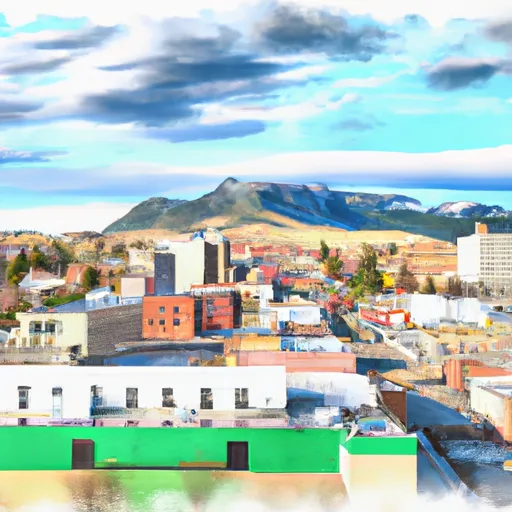-
 Snoflo Premium
Snoflo Premium
Get unlimited access to all our content
With no Ad interruptions! - Start Your Free Trial Login with existing account
Superior
Eden Index
Climate
8.0
•
Recreation
4.1
•
Community
•
Safeguard
4.6/10

Superior, Montana is a charming town nestled in Mineral County, surrounded by breathtaking natural beauty. It enjoys a continental climate, characterized by warm summers and cold winters. Average temperatures range from the mid-80s (°F) during summer months to the low 20s in winter, with occasional snowfall.
The town is located along the Clark Fork River, which enhances its hydrology constituents. The river not only adds to the scenic beauty but also offers a variety of recreational opportunities like fishing, boating, and kayaking. The area is also home to numerous lakes and streams, providing additional options for water-based activities.
Superior is an outdoor enthusiast's paradise, offering abundant recreation opportunities. The nearby Lolo National Forest boasts miles of trails for hiking, biking, and horseback riding, allowing visitors to explore the stunning landscapes and spot wildlife. Additionally, the nearby Clark Fork River provides excellent fly fishing opportunities, attracting anglers from far and wide.
With its favorable climate, beautiful waterways, and diverse outdoor recreation options, Superior, Montana is truly a haven for nature lovers and adventure seekers alike.
What is the Eden Index?
The Snoflo Eden Index serves as a comprehensive rating system for regions, evaluating their desirability through a holistic assessment of climate health, outdoor recreation opportunities, and natural disaster risk, acknowledging the profound impact of these factors on livability and well-being.
Climate Health Indicator (CHI): 8.0
Superior receives approximately
882mm of rain per year,
with humidity levels near 77%
and air temperatures averaging around
7°C.
Superior has a plant hardyness factor of
6, meaning
plants and agriculture in this region thrive during a short period during spring and early summer. Most
plants will die off during the colder winter months.
By considering the ideal temperature range, reliable water supplies, clean air, and stable seasonal rain or snowpacks, the Climate Health Indicator (CHI) underscores the significance of a healthy climate as the foundation for quality living.
A healthy climate is paramount for ensuring a high quality of life and livability in a region, fostering both physical well-being and environmental harmony. This can be characterized by ideal temperatures, reliable access to water supplies, clean air, and consistent seasonal rain or snowpacks.
Weather Forecast
Streamflow Conditions
Pend Oreille
Area Rivers
Pend Oreille
Snowpack Depths
Pend Oreille
Reservoir Storage Capacity
Pend Oreille
Groundwater Levels
Recreational Opportunity Index (ROI): 4.1
The Recreational Opportunity Index (ROI) recognizes the value of outdoor recreational options, such as parks, hiking trails, camping sites, and fishing spots, while acknowledging that climate plays a pivotal role in ensuring the comfort and consistency of these experiences.
Access to outdoor recreational opportunities, encompassing activities such as parks, hiking, camping, and fishing, is crucial for overall well-being, and the climate plays a pivotal role in enabling and enhancing these experiences, ensuring that individuals can engage in nature-based activities comfortably and consistently.
Camping Areas
| Campground | Campsites | Reservations | Toilets | Showers | Elevation |
|---|---|---|---|---|---|
| Big Pine FAS | 5 | 2,911 ft | |||
| Quartz Flat | 52 | 2,853 ft | |||
| Forest Grove FAS | None | 2,744 ft | |||
| Slowey | 16 | 2,667 ft | |||
| Cascade Trailhead | 15 | 2,689 ft | |||
| Forks FAS | 5 | 3,122 ft |
Nearby Fishing
Nearby Ski Areas
Catastrophe Safeguard Index (CSI):
The Catastrophe Safeguard Index (CSI) recognizes that natural disaster risk, encompassing floods, fires, hurricanes, and tornadoes, can drastically affect safety and the overall appeal of an area.
The level of natural disaster risk in a region significantly affects safety and the overall livability, with climate change amplifying these risks by potentially increasing the frequency and intensity of events like floods, fires, hurricanes, and tornadoes, thereby posing substantial challenges to community resilience and well-being.
Community Resilience Indicator (CRI):
The Community Resilience Indicator (CRI) recognizes that education, healthcare, and socioeconomics are crucial to the well-being of a region. The CRI acknowledges the profound impact of these elements on residents' overall quality of life. By evaluating educational resources, healthcare accessibility, and economic inclusivity, the index captures the essential aspects that contribute to a thriving community, fostering resident satisfaction, equity, and social cohesion.

